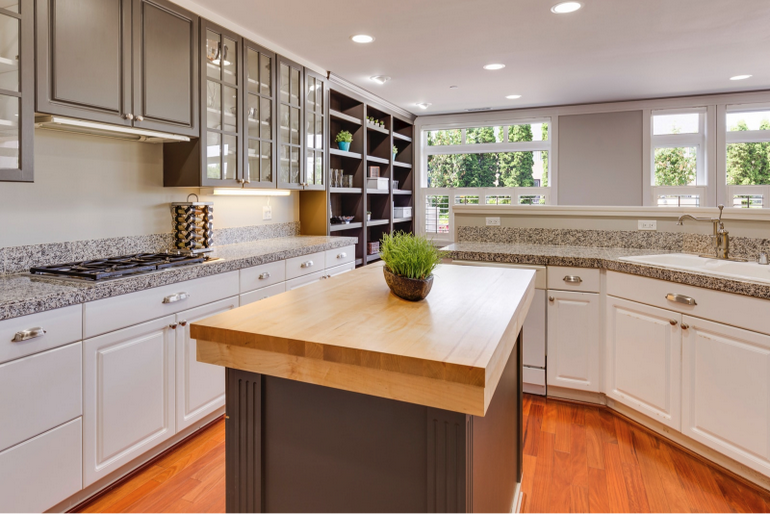
The kitchen is the busiest place in the home. It is where most foot traffic is experienced, family meals are cooked, and family gatherings are mostly held.
The floor of this hub should be able to withstand the foodstuff and oil spills, dropped dishes, and people moving in and out. Not all flooring materials are suited for the kitchen. Some materials last long with minimal maintenance costs, while others don’t.
While choosing your kitchen ground surface material, you should balance between function, comfort, and style. Your lifestyle also plays a significant role in determining the best option.
If you have kids who check in often, you should consider non-slip surfaces to guarantee their safety. Your style sense should also complement your kitchen design and size.
Whatever your preferences, choose a kitchen floor that will serve its purpose for years. Some of the materials you should consider for your kitchen include:

Hardwood material designed from engineered boards with a body of plywood or HDF and a wood layer on top will be ideal for the kitchen. This is because it has a stable makeup and UHF suitability.
To ensure durability, manufacturers use polyurethane and modern sealer finishes. Hardwoods with veneers are prone to moisture-related problems and stains. The surface can be repaired with sand and refinishing to renew its glow.
You can also opt for the earth-friendly and bacteria-resistant bamboo as well as cork designs. The materials resemble the hardwood types, but bamboo is harder and moisture-resistant. The only drawback with bamboo is its high cost and requires expert installation.
Linoleum floor is designed from 3 components, including linseed oil, wood, cork, and resin. It is durable, waterproof, and environmentally friendly. Cleaning linoleum is quite easy. The material is UFH compatible and hygienic as well. For best performance, you should get your linoleum surface sealed after it is laid. Also, you can add an extra grip to it by having the manufacturer design it with studs.
However, remember that linoleum is susceptible to damage. It can fade and dent with time and may form a yellowish tinge.







Vinyl floors are versatile kitchen surface solutions that are stain, water, and damage-resistant. They are easy to clean and comfortable under the feet. Vinyl can be laid over the existing floor surface with excellent results. It comes in different colors and patterns and is UFH-compatible as well. A good quality option comes with a thick layer that helps to protect against scratches and other damages.
When laid correctly, vinyl designs will last longer. They are ideal for bustling kitchens. Modern versions of this flooring type are crafted from high-quality materials that remarkably imitate stone or wood. They are mostly known as luxury vinyl flooring (LVF) and are available in the market as planks and tiles.
Concrete and resin options are ideal for use in ground-level kitchens. They require expert installation and sealing to ensure high levels of stain and water resistance. Concrete surfaces are UFH resistant and easy to clean. They are crack and chip resistant as well. If damaged, they can be resealed again. After installation, you can have them stained, polished, and treated for a resultant stylish, and beautiful kitchen floor. Concrete floors are suitable for modern kitchens.
The disadvantage of concrete ground surfaces is that they are cold and somehow hard to style. That is precisely why most people prefer other stylish designs over this option.
Ceramic tiles are manufactured from natural clay that undergoes glazing before it is shaped and fired under a furnace. They are quite durable andresistant to stains and water. Ceramic, terracotta, or porcelain tiles are UFH compatible, durable, and hygienic. They require low maintenance and are easy to clean as well. They are also not easily breakable, will survive hot material, and will last in your kitchen for years.
These tiles come in multiple colors, sizes, shapes, faux natural patterns, and mosaics. There are a lot of design options in the market for you to choose from. However, they can be cold under the feet and make you uncomfortable.
Laminate floors come in different realistic-looking planks and other designs that can resist spills. They mostly imitate tile or hardwood and are protected by a wear layer that makes them resistant to scratches and scuffs. They come in varied colors and unique shapes that give them an authentic look. Their grain is quite realistic. Laminate is UFH compatible.
Laminate material is ideal for busy kitchens that encounter regular food spills and feet traffic. It is very durable and easy to clean using simple procedures such as regular vacuuming, wiping, dusting, and sweeping. It, however, requires underlayment to prevent moisture and muffle sound.
Laminate designs are easy to install, and you can do it yourself. It uses less material compared to other surface options and doesn’t require oiling or waxing while in use.
The best flooring material for your kitchen will depend on your budget, priorities, kitchen space and style, and how busy it is.Whether you want a designer look to increase your home’s value, a DIY model, or an environmentally friendly option, a lot of unique and sturdy designs are available in the market near you. When it comes to kitchen floors, the possibilities are endless.